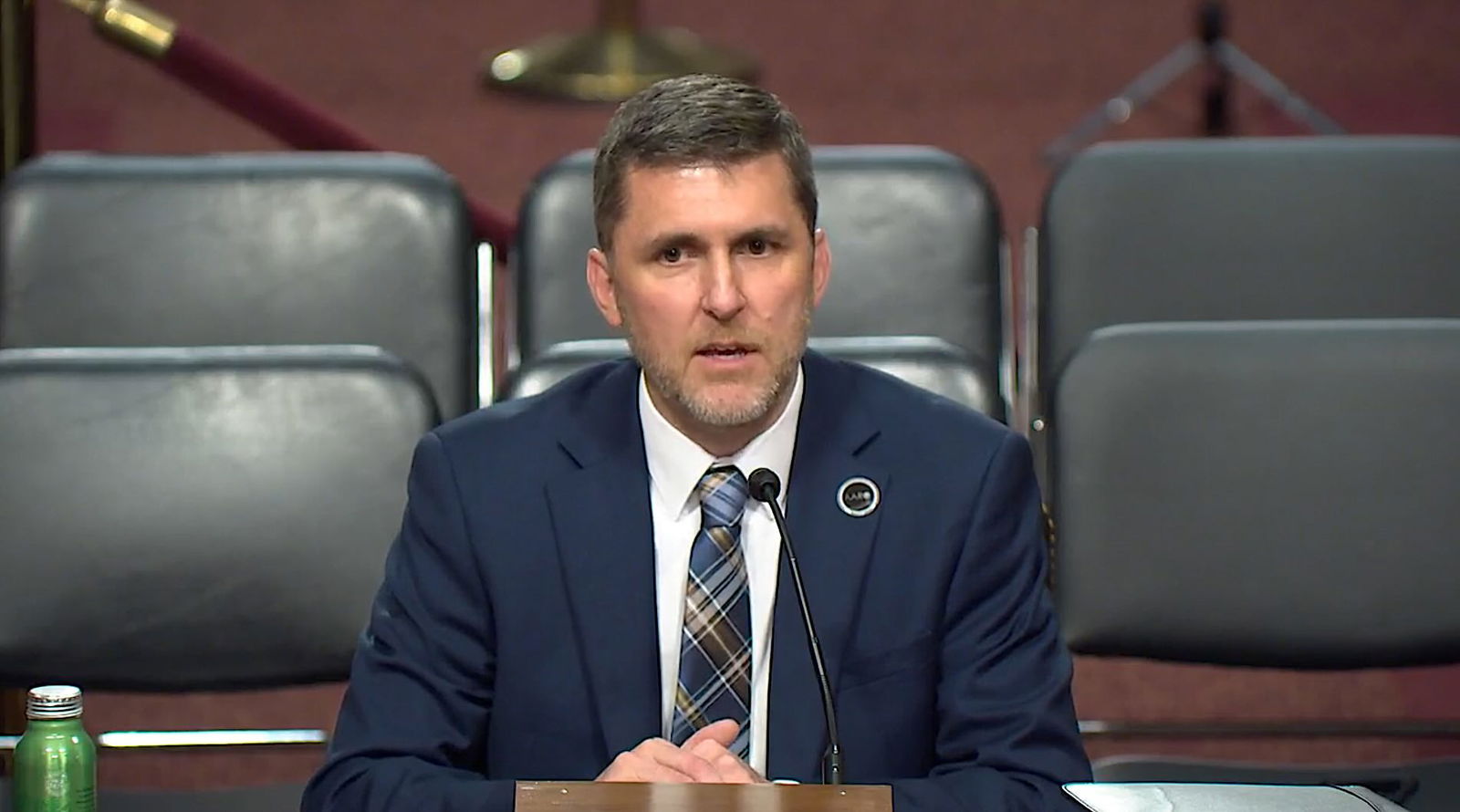The new director of the Pentagon’s All-domain Anomaly Resolution Office (AARO) confirmed to lawmakers on Tuesday that the U.S. is investigating what he characterized as “some very anomalous objects,” while providing an update on the Defense Department’s ongoing investigations into unidentified anomalous phenomena (UAP).
Dr. Jon Kosloski, who assumed the role of Director of AARO in August, made the comments during a hearing held by the Senate Armed Services Subcommittee on Emerging Threats and Capabilities overseen by U.S. Senator Kirsten Gillibrand (D-NY).
In his opening statements, Kosloski pledged that his office would continue to share information about AARO’s findings at the unclassified level, discussing several UAP cases his office has investigated, including a series of incidents which AARO says have now been resolved.
One of these, referred to as “The Puerto Rico Object,” involved a video of a purported UAP filmed in April 2013 from a U.S. Customs and Border Protection aircraft near Aguadilla, Puerto Rico. The video has been been a subject of independent public investigation and debate now for many years.
Kosloski told lawmakers the object in the video was assessed with high confidence by his office not to display any evidence of anomalous speeds or flight characteristics, and was “likely a pair of balloons or sky lanterns,” which Kosloski said had been “floating at about seven knots over the airport.”
Examples of AARO’s resolved reports also included a now-famous U.S. Navy video commonly known as “Go Fast” that first came to public knowledge in 2017, which Kosloski says represents an example of parallax.
“Through a very careful geospatial and intelligence analysis using trigonometry, we assess with high confidence that the object is not actually close to the water, but is rather closer to 13,000 feet,” Kosloski said.
“A trick of the eye called parallax makes it look like the object is moving much faster,” Kosloski added, referencing a report on parallax previously uploaded to AARO’s official website.
Another resolved UAP case, filmed in the Mediterranean from a drone observing the eruption of Mount Etna in 2018, appears to show a small object passing through the plume of superheated gas and ash produced by the volcano.
“This was a rather difficult case to resolve,” Kosloski said. “Through very detailed 3D modeling and pixel by pixel analysis of the object as it’s traversing across the clouds, the assess that the object was actually 170 meters away from the plume, and not flying through it.”
However, while many cases have been resolved by AARO, Dr. Kosloski cautioned against any perception that his office does not find at least some of the reports it receives genuinely anomalous.
“To be clear, AARO does not believe that every object is a bird, a balloon, or a UAV,” Kosloski said, adding that “we do have some very anomalous objects.”
Kosloski also said that his office has worked to ensure that U.S. personnel with information related to UAP or alleged U.S. government programs associated with such phenomena feel comfortable coming forward and speaking to AARO.
“We take that responsibility and those authorities very seriously,” Kosloski said, adding that he and his staff “have been reaching out to the broader community, encouraging folks who had talked to AARO personnel in the past, and maybe felt uncomfortable to come back to us.”
Prior to Kosloski’s appointment as AARO Director, the office’s investigations were led by Dr. Sean Kirkpatrick, who is currently the Chief Technology Officer for Defense and Intelligence Programs within the National Security Sciences Directorate (NSSD) at Oak Ridge National Laboratory.
It was unclear during Tuesday’s hearing whether Kosloski’s references to past instances where U.S. personnel may have felt uncomfortable speaking with AARO investigators had occurred during Kirkpatrick’s tenure. However, Kosloski told lawmakers that AARO has recently been “making great progress,” adding that several firsthand witnesses his office had spoken to about their UAP sightings “do feel comfortable coming back to us.”
Asked by Senator Gillibrand about UAP cases that merit further investigation, Kosloski explained that while some cases with insufficient data are placed into an active archive, there are others involving reportedly anomalous objects that AARO deems to be worthy of additional analysis.
One particularly intriguing unresolved case that Kosloski described involved a large orange orb or sphere observed floating several hundred feet above the ground by a law enforcement officer in the Western United States. As the officer approached the location believed to be directly beneath the object, he observed another object described as “blacker than black” and roughly the size of an automobile.
“As he got 40 to 60 meters away from the object, it tilted up about 45 degrees and then it shot up vertically,” Kosloski said, “and then it shot up vertically, he says 10 to 100 times faster than any drone he’s ever seen before.
“And it did that without making a sound, as far as he could tell from inside his vehicle,” Kosloski said. The object reportedly emitted very bright red and blue lights as it departed the scene, which illuminated the inside of the officer’s vehicle.
Another unresolved case involved a stationary cylinder that was observed for a short period hovering over a U.S. facility in the American southwest before abruptly disappearing. The object, observed by U.S. government contractors who were leaving the facility at that time, was described as being comparable in size to a commercial airplane, and was accompanied by a very bright white light.
“Obviously, an object that large [and] stationary—unless it’s a blimp—is unusual,” Kosloski said. “But then disappearing, we can’t explain how that would happen.”
In another instance, an aircraft flying parallel to another aircraft while filming it captured imagery of a much smaller object that appears to have passed between them at high speed.
Kosloski said AARO may be nearing a resolution with one of these three cases, but added that there are several others that are still currently under analysis by his office.
Asked by U.S. Senator Joni Ernst (R-IA) what the U.S. needs to be doing about UAP and what precautions should be taken by U.S. officials, Kosloski warned about stigmas that have long prevailed against the subject, which he said “opens the opportunity for an adversary… to come in and conduct some activity.”
“We need to do that, and we need to have more persistent monitoring,” Kosloski also told lawmakers of the challenges AARO faces with regard to collecting information about UAP, adding that in particular, monitoring at high security facilities should be a main priority.
“Whether it is a UAP, or it is a counter-UAS issue, that we need to have that complete domain awareness around our national security facilities,” Kosloski said.
Next year, Kosloski said AARO plans to roll out a public reporting mechanism at AARO’s website where members of the general public can download a reporting form and submit details about possible UAP sightings, along with attachments such as imagery. This simple reporting interface, Kosloski said, was chosen due to its cost effectiveness, in addition to being a system that he said could ensure the privacy of those members of the public who file reports.
“I think that the authorities that we have are remarkable,” Kosloski said at the conclusion of the short public session, thanking Gillibrand and other lawmakers, and adding that he believes AARO to be “well-resourced as an office.”
“The only ask that I would have is that you continue to champion us, particularly with witnesses,” Kosloski said. “Encourage them to come forward and report to us so we that we can have a more fulsome investigation of the potential historic or ongoing legacy programs,” Kosloski said.
Tuesday’s hearing followed the release of an annual report on AARO’s findings by Kosloski’s office last Thursday, just one day after a separate congressional hearing that also addressed the UAP topic.
Speaking with members of the media on a call last week following the release of AARO’s new report, Kosloski said that his office currently has “several particularly interesting cases.”
“We’re working on within the office, working with our partners to downgrade several of those cases, so we can talk about them publicly,” Kosloski said during the call.
“But there are interesting cases that I, with my physics and engineering background and time in the IC, I do not understand.”
“And I don’t know anybody else who understands them either,” Kosloski added.
Micah Hanks is the Editor-in-Chief and Co-Founder of The Debrief. He can be reached by email at micah@thedebrief.org. Follow his work at micahhanks.com and on X: @MicahHanks.

